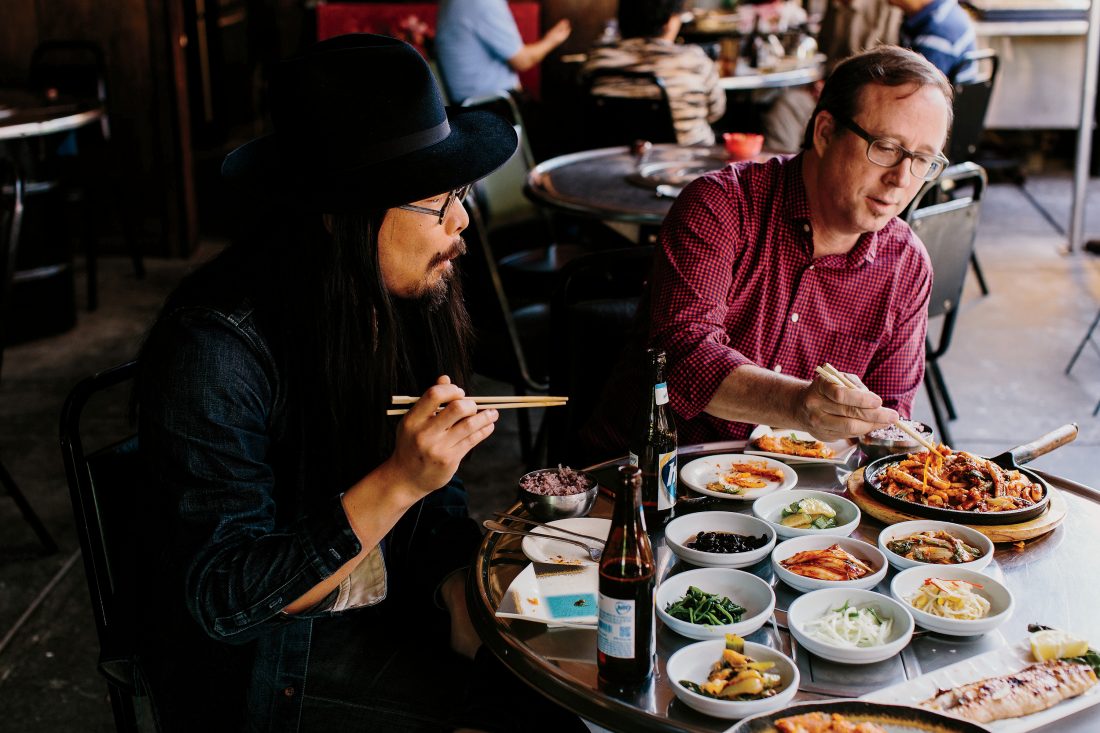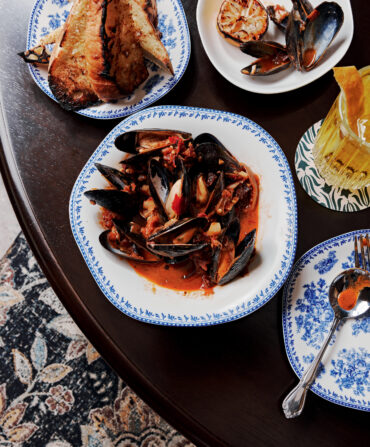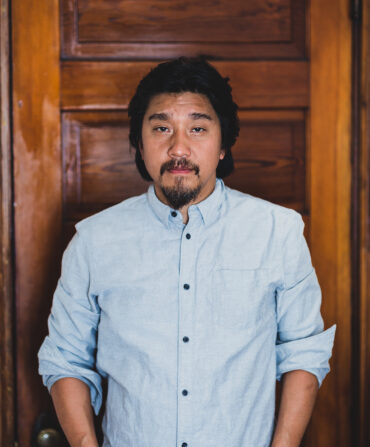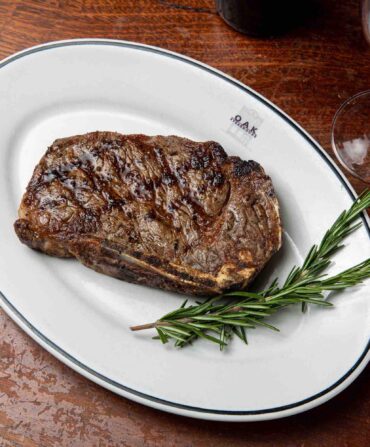The house music at C’est Si Bon segues from the Gone with the Wind theme to “Puff, the Magic Dragon” as Joe Kwon and I dig long-handled spoons into a chilled copper bowl, heaped with the Korean dessert called patbingsu. We stir the red beans into the shaved ice. We fold puffed rice cakes and toasted brown rice under a kaleidoscope of fruit cocktail. As the ice melts, we eat our way to the bottom of the bowl. Each bite brings a new crunch. Each slurp brings a new sweetness.
If you’re a fan of contemporary music, you probably know Joe Kwon’s name. Or you know his fretwork.
Joe is the cellist who bounds across the stage for the Avett Brothers, the North Carolina folk rock group that fuses a Doc Watson respect for tradition with bursts of agitated energy more often associated with bands like the Buzzcocks. He’s the kind of eater who documents his tour meals with a Leica, the kind of thinker who, in the midst of a conversation about the Korean fried chicken trend now sweeping the nation, says, “I never knew that other Koreans ate fried chicken. I always thought that my family ate it because we’re Southern.”
Northeast of Atlanta in Duluth, Joe and I discover a doppelgänger planet, at once Korean and Southern, a world familiar and odd. Powdered sweet potato flavors the lattes we drink. Orders for pan-fried calamari get slathers of gochujang chile paste. And double-decker shopping centers shelter barbecue joints where we drink shots of soju—the clear rice liquor that tastes like a cross between pinot gris and moonshine—and tend tabletop charcoal braziers, sputtering with slabs of pork belly and cones of shaved beef brisket.
Some of the foods ring familiar at C’est Si Bon, a strip-mall cocktail lounge run by a courtly Korean émigré who made first landfall in Charlotte and now serves pulled Carolina pork barbecue platters. So does much of the music that the owner, Chris Kim, plays. Dressed in button-down shirts and gray slacks, he takes the stage weekend nights to trill the piano and sing John Denver’s “Take Me Home, Country Roads” for the chair-dancing pleasure of a mostly Korean crowd, one of whom likes to park a four-door Maserati out front.
I would be exaggerating, though, if I said that the Atlanta we glimpse on our two-day jaunt looks and sounds and tastes like the South that Joe and I already know. Instead, as we dart through parking lots in our white Kia rental—ducking into a Korean bakery that serves hot dog and cheese croissants and a Christian bookstore that sells gilt-edged Bibles, dining at a barbecue restaurant that abuts an acupuncture clinic, and staring up at a concert billboard for a Korean Justin Bieber—Joe and I glimpse the beautifully diverse South we will all soon know, as immigrants to the region scratch out hybridized identities like deejays working the cultural equivalence of two turntables and a microphone.
We are both sons of the South. At White Windmill, a mod chain bakery with numerous locations on Atlanta’s northern rim, Joe and I eat a morning brace of fish-shaped mini waffles, stuffed with vanilla cream and toasted in flip-top irons, and share origin stories. He’s Korean, with a cream-colored face, round black glasses, and a well-coiffed mane. I’m a pasty white boy, with clunky green glasses and a high and tight haircut. But our childhoods mirror. Born in South Korea, he grew up in High Point, North Carolina, amid twenty-four acres of dense pines, in a house reached by a gravel road. I grew up near Gray, Georgia, on fourteen red clay acres, bordered by black walnut trees, where I too knew the crunch of gravel under my feet.
Joe and I met this past winter at a benefit in Raleigh, North Carolina, where he lives with his fiancée, the entomologist Emily Meineke. Over a long and boozy dinner, we recognized that we both deeply love our region. And we are both deeply committed to redefining our South for an inclusive future. When the Avetts took a rare break from touring, Joe and I schemed to eat our way toward détente.

Photo: Andrew Thomas Lee
Barbecue goes global at Heirloom Market.
We could have explored other Korean-Southern enclaves. Like the suburbs of Northern Virginia, where megamall teens queue for kimbap rolls, threaded with tuna fish and bound with mayo. Or the east side of Montgomery, Alabama, where Hyundai middle managers scarf platters of salt-roasted duck and drink thimbles of the fizzy fermented rice wine known as makgeolli. Or the tentacled and tangled frontage roads of Houston, where Korean Presbyterian churches abut Korean taco joints.
But we made our move in exurban Atlanta. Here, more than 50,000 Korean immigrants read a daily local Korean-language newspaper, listen to a Korean radio station, and watch three Korean television channels. Here, we sit for dinners at tables blanketed with saucers of chive kimchi, sweet-potato noodles, and pickled turnips, the traditional array of Korean small plates known as banchan.

Photo: Andrew Thomas Lee
A kimchi pancake and sides, called banchan, at Dongne-Bangne.
The tastes come fast and furious at Don Moon Ji, a postmodern jewel-box diner in Nukoa Plaza, where flat-screen TVs pulsate with lip-synching fuchsia-clad Korean pop stars, and the waitresses wear frilly black-and-white French maid outfits. First comes a bedroll-sized omelet, engorged with kimchi fried rice. Then a casserole of soy-bathed rice noodles and vegetables, pocked with chewy rice sticks.
Joe stops mid-chew to talk me through the textural complexities of the noodles. “These thicker ones are important,” he says. “Like the cracklings in the whole hog at the Skylight Inn. It’s about texture as well as taste.” Two bites later, I get what he means. And I get something deeper, too. By nodding to an iconic North Carolina barbecue joint while slurping Korean noodles, Joe’s not playing to my Southern sensibilities. He’s making sense of his own.
This South is dizzying. And at times disorienting. But patterns emerge on day two. Korean bakeries, serving house-made peanut cream rolls and sliced loaves of honeyed egg bread, are omnipresent here, as Starbucks are everywhere else. Many aspire to a vaguely continental vibe. At Café Mozart Bakery, a silhouette of the composer blazons the front door. Vincent Bakery, next to a Korean-owned Vietnamese restaurant called What the Pho, references a Van Gogh theme. At Hansel & Gretel, Brothers Grimm references are few, but chestnut crème–stuffed pastries are many. Some bakeries are vanguard boutiques that cater to the latter-day carriage trade. At Tree Story Bakery and Café, set in the same plaza as a hyper-modern Super H Mart grocery, the pastry chef wears a pleated toque while turning out croquettes stuffed with glassy sweet-potato noodles. And the proprietor, Jaewoo Lee, lights the bakery cases with stylish fixtures crafted from mason jars.
On day two I begin counting Korean barbecue restaurants and lose track at sixteen. Dongne-Bangne, on the backside of a failing strip mall, serves beef short ribs, cooked on a gas-fired brazier, mounted on an oil drum table. From a booth at Iron Age, a South Korean restaurant masquerading as a North Korean gulag, Joe and I griddle marinated slabs of pork belly as waiters in dull military fatigues, brightened by ribbon epaulets, snip lengths of floppy pork into bite-size pieces. When they shade from brown toward rust, we chopstick-drag the thick-cut slices of uncured bacon through a mix of sesame oil and salt, pile them onto wide rounds of sliced daikon, garnish with kimchi-drizzled romaine, tuck into taco shapes, and eat as if we are somehow still hungry.
Between batches of belly, Joe walks me through a multicourse feast he recently ate at the French Laundry, Thomas Keller’s temple of American haute cuisine. A skilled home cook who could hold his own in a restaurant kitchen, he carries on a side conversation about how to hatchet-cleave open a pig skull and make traditional headcheese. As we talk, he shuffles two iPhones, a white one for Avett Brothers business and a black one for Emily conversations, stacking one atop the other like a poker dealer shuffling a deck, or, more to the point of our expedition, a Southerner shuffling identities.

Photo: Andrew Thomas Lee
Table Hopping
Heirloom Market’s low-key exterior.
There are many ways to define the South. Few work. Mashups of geographical barriers and cultural traits fail us. The Mason-Dixon Line has long been out of whack. Overlays of the former states of the Confederacy rely on an ugly past that doesn’t reflect this present. I’ve long chased a more expansive definition of my people and our place. But I never suspected that one path to that definition would wend through a phalanx of Korean strip malls.
Before Joe and I took our trip to Seoul by way of Atlanta, I knew Korean foods in the way I know Italian wines. I could bark out a few nouns. Like Chianti and kimchi, Sangiovese and soju. After navigating these banchan beltways, I now see and taste a true New South, one that first took root in the exurbs and is now going mainstream on Main Street.
Our first glimpse of that future actually came early in the trip, back inside the Perimeter at Heirloom Market BBQ, run by former K-pop star Jiyeon Lee and her husband, Cody Taylor, a self-described Tennessee hillbilly. From a perch on the side deck, Joe and I ate our way through their menu, starting with tempura fried sweet potatoes and green tomato kimchi, before moving to hickory-perfumed and miso-marinated brisket. At Sobban, the second restaurant from the same team, set in a stylishly reinterpreted Arby’s, we ate hush puppies made from ground soybeans, and shrimp and rice grits puddled with makgeolli butter sauce. We ogled the seared trout with kimchi fried okra. And we reflected on the honest and easy marriage of Southern and Korean cultures.
Two days and more than fifteen meals later, Joe and I now know enough to say that, as the Magnolia Curtain drops and the South accommodates new arrivals with new palates, Korean immigrants—who were not born here but, more important, choose to live and work here—may prove as key to defining the culinary path of this place as those of us who spent our childhood days in knee pants, running barefoot down gravel drives.









